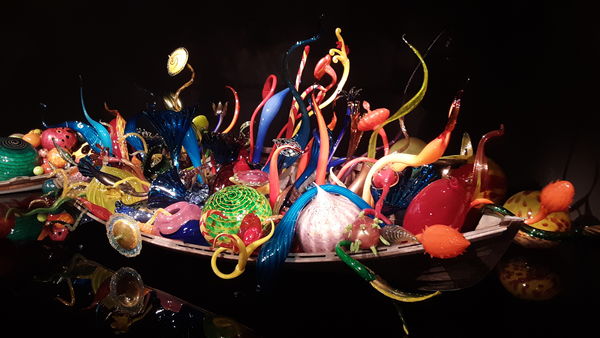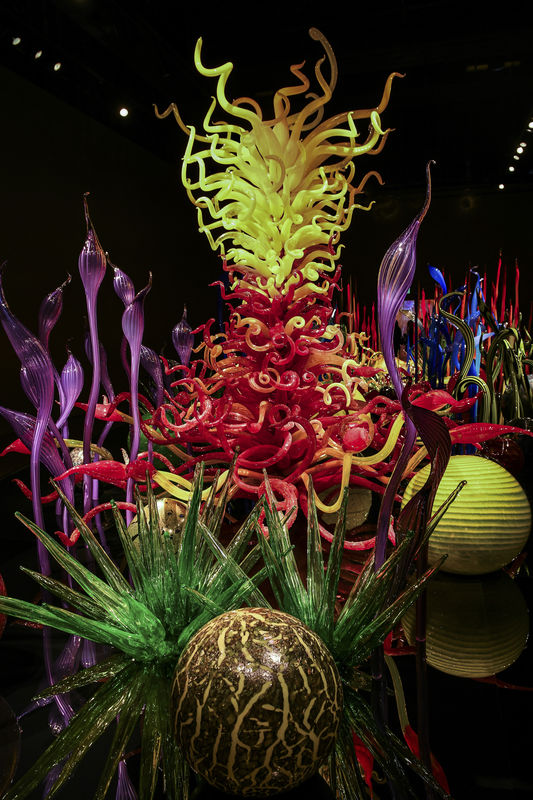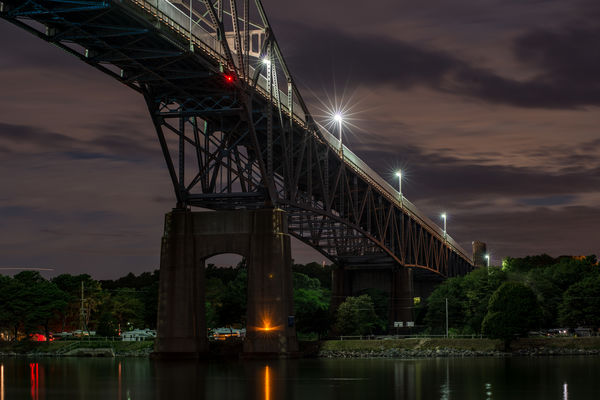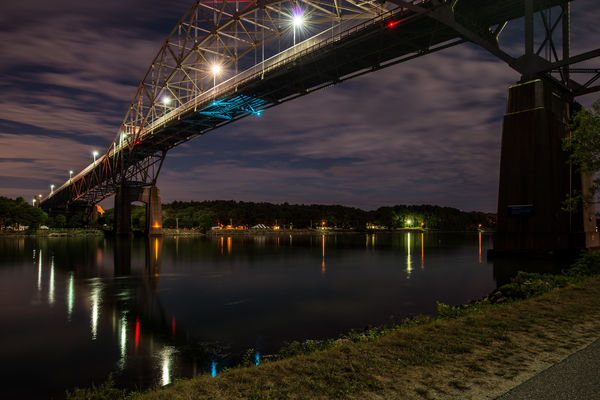Low Light Photography
Feb 21, 2021 20:38:45 #
imagemeister wrote:
Impressive example ........love that Sony .......thanks for sharing
You're welcome!
I took the shot using my instincts and whatever showed up in the viewfinder, not knowing if the image was going to be close to usable and I was really surprised. Like yourself - I love that camera, and even more than 3 yrs later it still impresses. Especially when it defies all the test data and experts who insist it can't work under those conditions.

Feb 21, 2021 21:40:26 #
larryepage wrote:
I would suggest a couple of things...first, there ... (show quote)
You're example is from the Chihuly Garden and Glass Museum in Seattle. It is hardly a low light situation. The lights on the glass are quite bright. Your photo is fine, but it is the same as shooting a school play on a brightly lit stage. The only low light is peripheral to the subject, and in your photo it goes to black, although in the museum it is far from black.
Not faulting your photo at all, just like Ron said, it isn't low light photography.
Feb 21, 2021 21:46:35 #
E.L.. Shapiro wrote:
Shooting in low light- very low light is no longer... (show quote)
Good post. Agree completely.
Feb 21, 2021 21:47:43 #
larryepage wrote:
You are correct that ISO 400 is not very high by today's standards. But 15 years ago, it was. In fact, I had a Nikon Coolpix P3 that did not go beyond ISO 400 at all. I selected that image from a number of years ago partly to demonstrate that today's ISO 3200 is yesterday's ISO 400... It sounds like a huge difference, but in reality is just three stops.
The reality is just three stops? That is the difference between a blurry photo of basketball players in a dark gym, or a tack sharp properly exposed photo. It is a huge difference.
Feb 21, 2021 22:12:38 #
larryepage
Loc: North Texas area
btbg wrote:
The reality is just three stops? That is the difference between a blurry photo of basketball players in a dark gym, or a tack sharp properly exposed photo. It is a huge difference.
One of the interesting things about photography is that three stops can at the same time be a small difference and a huge difference...
Feb 21, 2021 23:53:01 #
I got to visit Seattle on New Years Day 2020; Chihuly Gardens and Glass was on my "must see" list. Because I did not know what restrictions there might have been, I set the ISO on my D850 to 800 while inside the building. I used a Nikon 24-70 f/2.8 non VR lens that day.
Where I really encountered low light photography was the summer of 2019; took our granddaughter to Disneyland in CA, while there we got to see "Phantasmic", the light and fireworks show after dark. The in park regulations for tripods and monopods were so vague, I set my D850 to ISO 1600 and found something solid to rest on during the show. My favorite shot was the backside view of the pirate ship after it passed by. Just getting a focus lock was a challenge.
The image the OP posted, the boat, that is my wife's favorite shot from Chihuly; whereas my personal favorite is "Mille Fiori", the image attached. The attached boat shot was taken with my cell phone camera.
Where I really encountered low light photography was the summer of 2019; took our granddaughter to Disneyland in CA, while there we got to see "Phantasmic", the light and fireworks show after dark. The in park regulations for tripods and monopods were so vague, I set my D850 to ISO 1600 and found something solid to rest on during the show. My favorite shot was the backside view of the pirate ship after it passed by. Just getting a focus lock was a challenge.
The image the OP posted, the boat, that is my wife's favorite shot from Chihuly; whereas my personal favorite is "Mille Fiori", the image attached. The attached boat shot was taken with my cell phone camera.
Feb 22, 2021 00:56:39 #
While at Chihuly, I returned to the boat exhibit just to get a few more shots and make sure I had captured the reflections on the floor in front of the boat. The second shots with the D850 came out much better than the initial ones, partly because there was no one in that room the second time through. I got to take my time getting the shots.
Feb 22, 2021 08:22:09 #
larryepage wrote:
I read this after I wrote it. It rambles some. I... (show quote)
I guess I still don't really understand your primary point here, but I didn't mean to make you defensive. I only wished to point out the performance differences in our tools do matter to most of us here and that this is a good place to get some first hand information and feedback. While there can be some conflicting responses to a question, one can still learn quite a bit by comparing and considering different points of view and I wouldn't be here on a daily basis if this wasn't true.
Anyway, your statement above: "That limit will be different for different cameras, but will always be there" pretty much proves my point. However, you then turn right back around and state that "Yes equipment capability matters, but no the difference does not." I find that to be rather inconsistent and contradictory to say the least!
While I have agreed from the start that technique is indeed important, I will also state that the more I learn, the more I seem to care about performance issues of my equipment and I think that point may be somewhat universal out there. All in all, my only point is that your original post seemed to denigrate those posts that discuss performance issue differences and imply that one's technique should be improved rather than worry about those differences. While these differences can be very small as technology advances it all matters to me and probably many others on this site. In any case, I'm sorry if I offended you or anyone else here. Good luck and good shooting to all.
Feb 22, 2021 08:30:57 #
petrochemist
Loc: UK
That's a nice shot, but IMO 1/20s f/2.8 & iso400 is a VERY long way from what I'd consider 'low light' for modern cameras. I routinely hand hold shots in darker conditions and all my cameras are over 5 years old.
Feb 22, 2021 11:10:49 #
larryepage
Loc: North Texas area
There have been several replies questioning whether this is really a low light shot and claiming (by folks who have also been there) that this is a bright exhibit, not a dark one. Been thinking about how to best reply, so I apologize for the delay.
To address the second issue first, yes, it is a low light scene. I have an appointment on Wednesday with a friend who has a museum science degree during which I have asked her to share some thoughts and secrets about museum lighting and to show me how it is applied in this exhibit. I'll come back with more specifics after our visit, but will tell you that (with a very few notable exceptions in some very specific cases) there are no bright museum exhibits. This is because the energy in light waves causes degradation to almost everything it touches. Since the "prime directive" in museums is preservation, bright light is a huge no-no. A big area of focus in the museum art, then, is making observers think the exhibit is brightly lighted, when in fact, it is not. So ambient areas tend to be dark, finish colors are carefully chosen, and other choices are made so that it is possible to make exhibits stand out the same as if they were brightly illuminated.
Now...to the first issue. My exposure here was 1/20 second at f/2.8 at ISO 400. If I were to to return and try to duplicate this shot, probably with my D500 this time, I would probably set the ISO at 1200, stay at f/2.8, and set the shutter at 1/60 second, which is the same exposure. If I followed the principles that a lot of you do, and moved away from wide open to, say, f/5.6 in the belief that I could get a sharper image, I would now find myself at an ISO of 4800. That sounds pretty much like a low light exposure to me. If I were shooting a basketball game in a gym with equivalent lighting and wanted a shutter speed of even 1/250, I'd have to go to an ISO of 9600 even if I changed the aperture to f/4 to gain a slight bit of depth of field. So yes, this is a low light situation.
I think what's interesting is that quite often, things are not as they first appear. It is necessary to think through them a little bit to see what is actually going on.
To address the second issue first, yes, it is a low light scene. I have an appointment on Wednesday with a friend who has a museum science degree during which I have asked her to share some thoughts and secrets about museum lighting and to show me how it is applied in this exhibit. I'll come back with more specifics after our visit, but will tell you that (with a very few notable exceptions in some very specific cases) there are no bright museum exhibits. This is because the energy in light waves causes degradation to almost everything it touches. Since the "prime directive" in museums is preservation, bright light is a huge no-no. A big area of focus in the museum art, then, is making observers think the exhibit is brightly lighted, when in fact, it is not. So ambient areas tend to be dark, finish colors are carefully chosen, and other choices are made so that it is possible to make exhibits stand out the same as if they were brightly illuminated.
Now...to the first issue. My exposure here was 1/20 second at f/2.8 at ISO 400. If I were to to return and try to duplicate this shot, probably with my D500 this time, I would probably set the ISO at 1200, stay at f/2.8, and set the shutter at 1/60 second, which is the same exposure. If I followed the principles that a lot of you do, and moved away from wide open to, say, f/5.6 in the belief that I could get a sharper image, I would now find myself at an ISO of 4800. That sounds pretty much like a low light exposure to me. If I were shooting a basketball game in a gym with equivalent lighting and wanted a shutter speed of even 1/250, I'd have to go to an ISO of 9600 even if I changed the aperture to f/4 to gain a slight bit of depth of field. So yes, this is a low light situation.
I think what's interesting is that quite often, things are not as they first appear. It is necessary to think through them a little bit to see what is actually going on.
Feb 22, 2021 11:46:30 #
larryepage wrote:
There have been several replies questioning whethe... (show quote)
But it is not low light in the way most photographers understand and use the term. You are in a controlled setting. Most low light issues are not in controlled settings. They are in real world settings. Studio, museum, astrophotography and the like make up a very small slice of low light photography and simply do not represent what most photographers have in mind when discussing low light. Live events like weddings, concerts, late night street photography, travel, spelunking even. These are more representative of what most have in mind when they say "low light"
Feb 22, 2021 12:54:50 #
larryepage
Loc: North Texas area
I understand that there is a wide range of subjects covered by this topic. Gene and others have shown us some of them. But the physics is the same for all of them. It was just offered as one example.
Feb 22, 2021 13:16:00 #
petrochemist
Loc: UK
larryepage wrote:
I understand that there is a wide range of subjects covered by this topic. Gene and others have shown us some of them. But the physics is the same for all of them. It was just offered as one example.
When I last shot film dim interior shots like museums would certainly have been low light, but they wouldn't have been a challenge to handhold with my first DSLR (released 2006). Today low light typically means a moonlit landscape (without a full moon), but I think fast action shots in those museum type settings might also qualify.
Feb 22, 2021 13:45:11 #
larryepage wrote:
.......................
................. It is necessary to think through them a little bit to see what is actually going on.
................. It is necessary to think through them a little bit to see what is actually going on.
Flagrant affront to UHH tradition.
——————————————————
FWIW I did more than plenty of low light documentary style in interiors where ASA 1250 gets you “classic” low light settings that are fast lenses wide open and barely handholdable speeds. While you could clearly see people’s eyelashes, they were unashamedly made of film grain.
The pix acoarst are boldly grainy with terrific BW tonality cuz ASA 1250 is pretty conservative for EK’s TMZ3200.
The above is a classic well recognized definition of low light. The same cannot be said for HS gyms. They’re NOT low light. They can be difficult venues for shooting action without flash, but that doesn’t define “low light”. Lacking the practiced skill to shoot no-flash sports at 1/60 sec with a 90mm at f:4.0 does not redefine low light.
Basically, a good low light digital camera is not especially noiseless when deprived of generous exposure, but at least it avoids blotchy blobs and smears of unwanted color and distracting visible artifacts like banding.
Expecting a broad range of DR is as silly as expecting no noise. You’re gonna work with about 5 stops of DR and almost zero shadow detail just to get action shutter speeds and tolerable DoF. A good low light camera delivers those compromised images without loading them with ugly artifacts, but it’s not gonna make a gym look like a sunny day in the park, just like TMZ135 is never gonna look like PX120 ... and anywho why SHOULD it ? Why should you expect it to ?!?!?
Feb 22, 2021 14:37:55 #
larryepage wrote:
There have been several replies questioning whethe... (show quote)
Well, this first image was taken at EV +.33 - 30 sec, F6.3, ISO 100, D800, 80-200mm F2.8 AF-D
I used F6.3 because I was after the star patterns on the lights - the extra sharpness didn't hurt.

The second was at even lower EV - minus .33 - 30 sec, F5.0, ISO 100, D800, 24mmF3.5 PC-E. When people talk about low light, these are the light levels that come to mind. "Low Light" is actually pretty vague - yes, your images are taken in low light. But so were mine - and a full 7 stops less light than yours. There is no right and wrong here - just pointing out that things are sometimes relative. I can fully understand why some here may not qualify your images as low light. But you are on the "high" side of low light.
.
If you want to reply, then register here. Registration is free and your account is created instantly, so you can post right away.





